Last updated: January 8, 2024
Article
A Legacy of Contamination
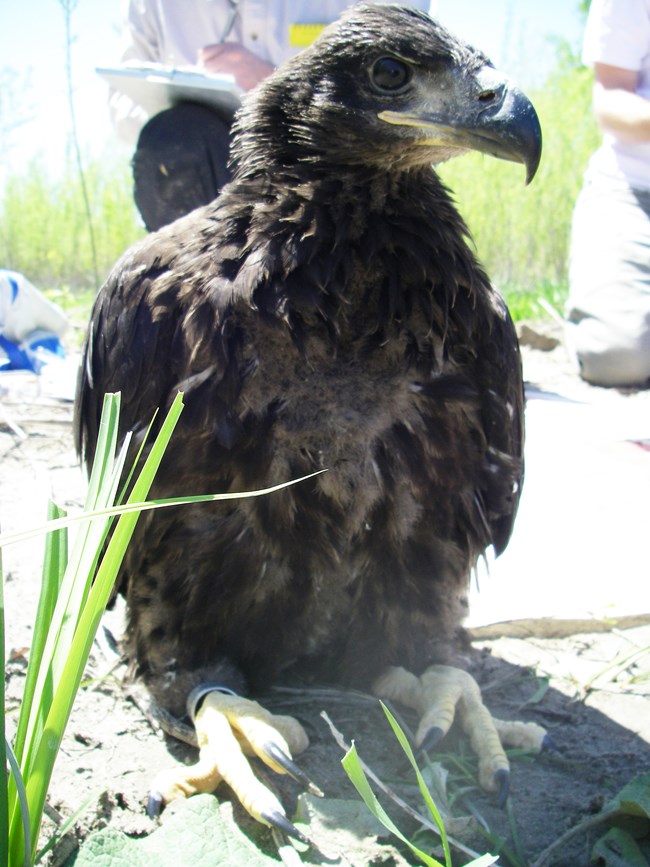
NPS / T. Gostomski
Human-made contaminants released into water, air, or on land often end up in lakes and rivers. Legacy contaminants are chemicals once used in the U.S. but then discontinued or outright banned. Yet, in many cases, they linger in soil and water, slowly breaking down and continuing to affect wildlife long after they were deposited.
DDT––a popular and widely used pesticide after World War II––was banned from use in the United States in 1972, but continued to be produced here and shipped to other countries until 1985. DDT can take more than 30 years to degrade in the cold, clay soils found in some areas of the upper Midwest, and long-range transport in the atmosphere continues to bring DDT here from overseas, infusing soil and water with this toxic chemical. Similarly, polychlorinated biphenyls (PCBs)—a group of industrial chemicals used mainly in electrical equipment—were banned in 1979 but are still found in the blood and tissues of Great Lakes wildlife.
These chemicals make their way into bald eagles through their diet (primarily fish). Concentration of the chemicals increases with each rise in the food web, through a process known as biomagnification. At a certain concentration level, both of these contaminants are known or hypothesized to adversely affect wildlife. As fish-eating mammals, humans are also vulnerable to this risk.
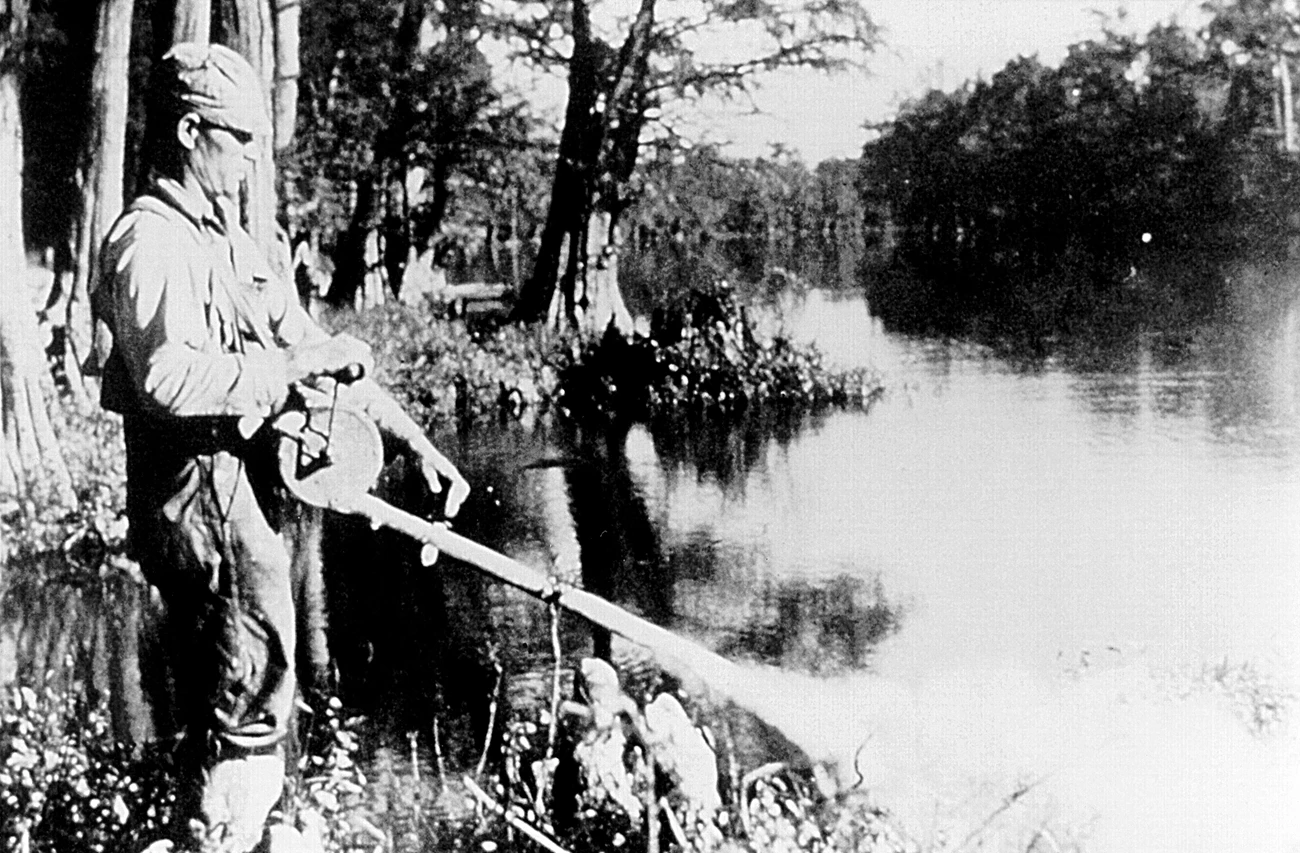
Centers for Disease Control and Prevention (https://phil.cdc.gov/default.aspx)
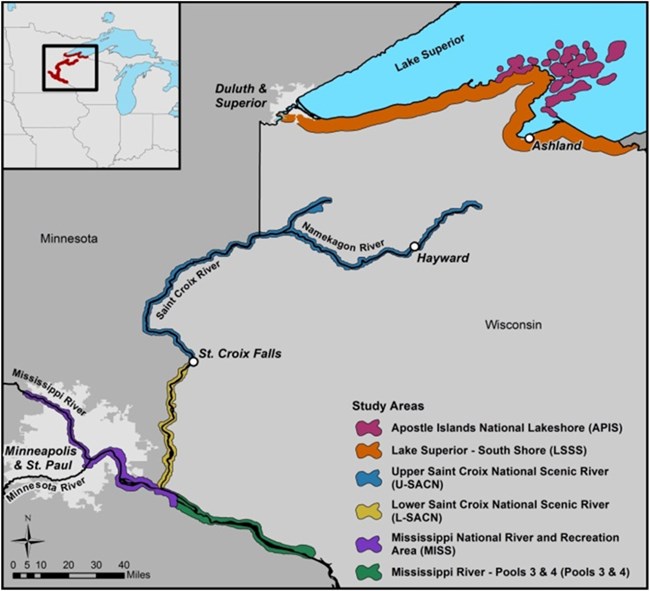
Bald Eagles as Biosentinels
Bald eagles are at the top of the aquatic food web, making them good indicators of environmental contamination. Nestling eagles are particularly useful because their food comes from a definable local area. Eaglet blood tells us about acute contamination that is happening right now. Their feathers, which are molted and grown anew each year, harbor long-term contamination that builds up (bioaccumulates) and can cause health and reproductive problems.
Great Lakes bald eagle nestlings have been used to monitor contaminants for over 30 years. The Wisconsin Department of Natural Resources did such monitoring along the south shore of Lake Superior and in the Apostle Islands from 1989 through 2002. Then, from 2006 through 2015, the National Park Service Great Lakes Inventory and Monitoring Network monitored eagle nestlings at Apostle Islands, the St. Croix and Namekagon Rivers, and the upper Mississippi River (see map).

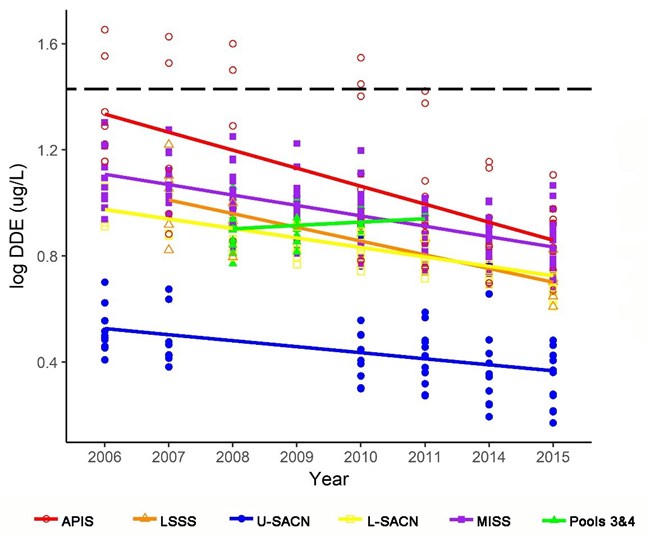
Trends
DDE
DDE is one of the most common breakdown products of DDT. Eaglets raised in the Apostle Islands had higher concentrations of DDE than eaglets from the Mississippi National River and Recreation Area and the St. Croix National Scenic Riverway. This is likely due, in part, to the slow break down of contaminants in the deep, cold waters of Lake Superior. The lowest concentrations were found in the upper portions of the St. Croix Riverway (above St. Croix Falls, WI) (see Figure 1).
From 2006 through 2015 (10 years), DDE concentrations decreased at a rate of 5.8% per year across the region. This rate of regional decline is consistent with the 5.5% per year decline seen over 26 years among eaglets from the two Lake Superior study areas (APIS and LSSS).
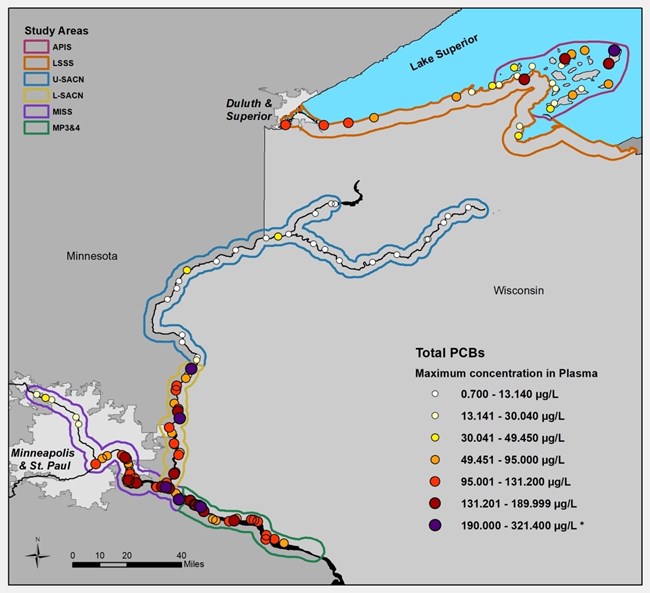
Polychlorinated Biphenyls (PCBs)
PCBs are often reported as total PCBs, which for our study is the sum of 75 different types (also called congeners) of PCBs found in environmental samples. We found the highest levels of total PCBs in nestlings from Pools 3 & 4 of the Mississippi River, L-SACN, and MISS. Moderately high levels on Lake Superior (APIS and LSSS), and the lowest levels at U-SACN (Figure 2). However, since our monitoring began in 2006, average (geometric) PCB levels for all six study areas have always been below the estimated threshold for adverse reproductive effects on eagle populations (190 µg/L).
We did not see a significant decline in total PCBs from 2006 through 2011 across the six study areas. However, for six types of PCBs with toxicity similar to dioxin (one of the most highly toxic pollutants), we found a decline of 2.7% at both APIS and LSSS over 16 years (Figure 3).

Eli Nichols for Eco-Ascension Research and Consulting
Management Implications
We expect DDE concentrations to continue declining slowly or reach a plateau at low levels without further management efforts. However, periodic monitoring is recommended to better understand the complete trajectory (from height of use through banning and the eventual low point) of this toxic chemical. The cost of measuring DDE is relatively low and includes the parent material DDT.
Continued monitoring of DDT will be important because of the potential for expanded use of this compound in the tropics and subtropics to control mosquito populations in the face of global warming. If DDT use increases then we could expect some transport to our area through the atmosphere and from migratory birds. This in turn will add to the DDE burden, which is the highly toxic product of DDT.
We expect PCB concentrations to also continue their slow decline and to reach a plateau at low levels. Managers can enhance this decline by continuing to collect PCB-containing equipment and products and by banning and/or enforcing bans on unnecessary burning of petroleum-based products such as plastics and Styrofoam that emit PCBs when burned at low temperatures. The continued use of burn barrels to dipose of garbage constitutes a significant source of PCBs and dioxins. Several Great Lakes states and provinces have banned the use of burn barrels, but PCB levels in wildlife should continue to be measured periodically to determine the effectiveness of education and enforcement.
The bald eagle has been established as a bioindicator species by multiple agencies and monitoring programs throughout the Great Lakes region. The position of the bald eagle at the top of the aquatic food web, the wealth of historical data, and the regulatory imperatives all support continued monitoring of this iconic species.

Jim Campbell-Spickler / Eco-Ascension Research and Consulting
Tags
- apostle islands national lakeshore
- mississippi national river & recreation area
- saint croix national scenic riverway
- contaminants
- glkn
- eagles
- ddt
- pcbs
- apostle islands national lakeshore
- st. croix national scenic riverway
- mississippi national river and recreation area
- mississippi river
- lake superior
- great lakes network
